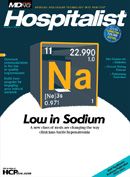Publication
Article
MDNG Hospital Medicine
Net Guide: Pulmonary Embolism
We searched the Internet for pulmonary embolism resources so you don't have to.
//The Educated PatientTM
What Are Anticoagulants and Antiplatelet Agents?
This resource from the American Heart Association is designed to educate patients about the role of anticoagulants and antiplatelet agents, explaining in simple terms how they work to reduce blood clots, and what patients need to know when taking these medications. The site identifies situations in which a doctor should be notified—such as urine that is red or dark brown or more menstrual bleeding than normal—and stresses the importance of asking a doctor before taking additional medications while on anticoagulants. Visitors can also find information about aspirin, links to more resources, and a form to write down questions before an appointment.
Link Code: h4326
Pulmonary Embolism
Patients can turn to this page from the Society for Vascular Surgery site to learn basic facts about pulmonary embolism, “a blood clot that forms in a vein, travels through your bloodstream, and lodges in your lungs.†Colorful diagrams are used to depict what happens during a pulmonary embolism; visitors can also learn what causes the event; what are the symptoms and risk factors; how it is diagnosed and treated; and what they can do to prevent it from occurring in the future, such as wearing elastic compression stockings to prevent blood from pooling in the veins, and staying hydrated while traveling.
Link code: h4327
//Medical WebsitesPainful Plaques Shortly After Hospital Discharge
Pop quiz, hot shot. Think you can properly diagnose a legion on a patient who is following up after experiencing her first pulmonary embolism? Then visit this site, which includes a photo quiz originally published in American Family Physician (the journal of the American Academy of Family Physicians) in 2008. View the image—which was submitted by physicians from the Mountain Area Health Education Center Family Medicine Residency in Asheville, NC—and read the description, then choose the diagnosis you think is correct. The answer is provided, along with a detailed discussion of the case study.
Link code: h4311
//Clinical TrialsStudy to Develop a Reliable Nomogram that Incorporates Clinical and Genetic InformationStudy Type: Interventional
Age/Gender Requirements: 18 years+ (male/female)
Sponsor: Brigham and Women’s Hospital
Purpose: In this research study, investigators seek to identify a reliable and safe method of setting the dose of warfarin in adults with any newly diagnosed condition that will require treatment with the medication for at least 4-6 weeks, such as deep venous thrombosis or pulmonary embolism.
Link Code: h4364
//Online CME
Clinical Challenges in the Management of Acute Pulmonary EmbolismCredits: 2.00
Fee: $40.00
Expires: May 4, 2013
Multimedia: Audio/Video
This activity will discuss management of adult patients with acute pulmonary embolism (PE), “with an emphasis on pathophysiological and evidence-based algorithms for the management of acute PE syndromes.†It will also examine the “treatment of complicated PE patients, including those with contraindications to fibrinolysis and therapeutic anticoagulation,†and touch on the management of chronic oral anticoagulation for patients with PE and its related pitfalls.
Link Code: h4335
Deep Vein Thrombosis in Focus: Expert Perspectives on Reducing the Burden of Venous ThromboembolismCredits: 0.50
Fee: None
Expires: December 22, 2010
Multimedia: Audio/Video
Available via ReachMD’s satellite radio station and iPhone application in addition its website, this program is designed to address the need for appropriate management practices for venous thromboembolism (VTE) events. Led by Ann K. Wittkowsky, PharmD, Director of Anticoagulation Services at University of Washington Medical Center, the course discusses evidence-based guidelines and quality measures for VTE risk stratification in the acute-care setting, and the implementing of guideline-based VTE prophylaxis in at-risk hospitalized patients, among other topics.
Link code: h4336
//Events
November 4-7, 2010
American College of Phlebology 2010 Annual CongressRenaissance Orlando Resort at Sea WorldOrlando, FL
Link code: h4371
February 23-26, 2011
American Venous Forum (AVF) 23rd Annual MeetingHilton San Diego Bayfront
San Diego, CA
Link code: h4372
PHARMA FOCUS
Xarelto (Rivaroxaban)
Clinical Trials
Rivaroxaban in Patients with Acute Symptomatic Pulmonary Embolism (PE) with or without Symptomatic Deep-vein ThrombosisStudy Type: Interventional
Sponsor: Bayer; Johnson & Johnson Pharmaceutical Research & Development, LLC
Age/Gender Requirements: 18 years+ (male/female)
Purpose: Researchers will compare the efficacy of rivaroxaban to enoxaparin over “a study treatment duration of 3, 6, or 12 months in patients with confirmed acute symptomatic PE with or without symptomatic DVT.â€
Link Code: h4365
eAbstractNovel Oral Anticoagulants in Development: Dabigatran, Rivaroxaban, and ApixabanJournal: American Journal of Therapeutics (June 2010)
Authors: Sattari M, Lowenthal D
Purp ose: To determine the effectiveness of novel anticoagulants for the treatment and prevention of venous thromboembolic disease.
Results: “With their potentially consistent and predictable clinical profile, oral formulation, and decreased need for coagulation monitoring, these new agents will likely increase the use and duration of anticoagulation treatment in thromboembolic disorders and reduce the burden associated with longterm management.â€
Link Code: h4356
From the HCPLive Network
Mobile Compression Device Effectively Prevents Thrombosis after Joint Replacement SurgeryA mobile compression device is as effective as medication at preventing the formation of blood clots after hip replacement surgery, but provides greater patient safety, according to a study published in the Journal of Bone & Joint Surgery.
CoaguSense’s Home-Use Blood Coagulation System Gets FDA OKLocated in Fremont, CA, CoaguSense has obtained FDA approval of its portable PT/INR (Prothrombin Time/International Normalized Ratio) analyzer for patient self-testing (PST) by prescription. Consisting of a low-cost meter and disposable test strip, the device detects blood clotting time for patients stabilized on oral anti-coagulants warfarin or Coumadin.






